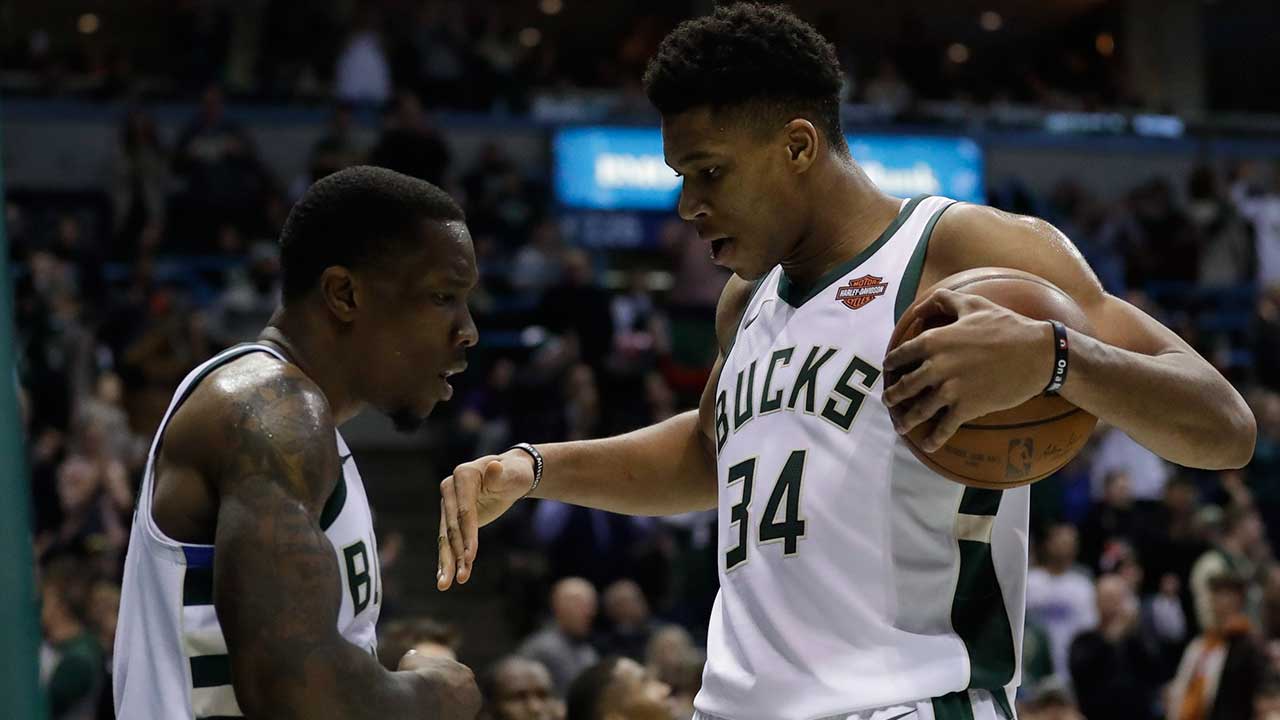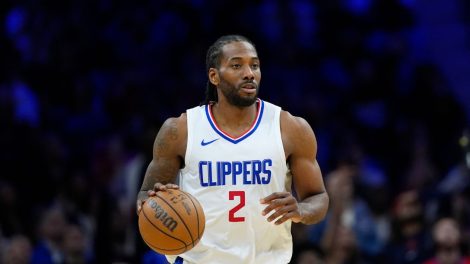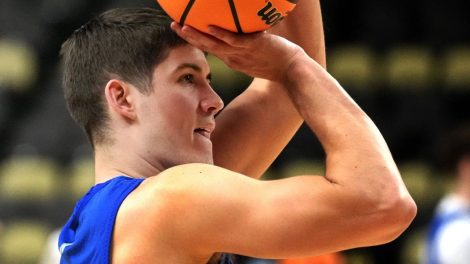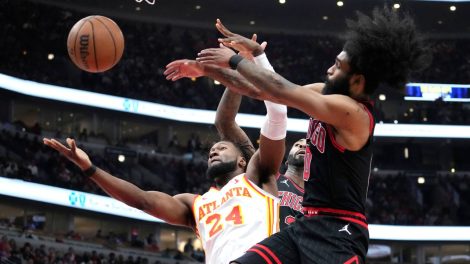The start of a new season brings the excitement and anticipation of Christmas and New Year’s Eve at the same time.
Teams can turn the calendar over and start off on a clean slate. The players teams have acquired over the off-season are the toys they’ve long been waiting to unwrap and, well, play with (commiserations: Gordon Hayward).
Culture resets, superstars in new homes and an overbearing father were just some of the storylines to look forward to in this 2017-18 NBA season, but the best gifts are the unexpected ones. So far this season, that gift has been remarkable comebacks.
When a team stretches a lead to 20 points or more, the probability of that team losing is minimal. There have been 12,300 games played over the past 10 seasons, and this Everest has been conquered a grand total of 100 times (0.81 per cent of games) per NBA Miner. The number of times teams have overturned this seemingly impossible deficit for four of the past five seasons is 11.
On Thursday night, it happened twice, and so very nearly thrice.
First, the Milwaukee Bucks rode Giannis Antetokounmpo and Eric Bledsoe to come back from 20 down against the Minnesota Timberwolves, before Kyrie Irving’s Boston Celtics made the even more improbable comeback from 26 down against the Houston Rockets. The Portland Trail Blazers also came back to beat the Philadelphia 76ers, but their largest deficit was 18.
This marked the 11th occasion already this season that a team overcame the 20-point barrier, and only 520 of the 1,230 scheduled games have been played. That’s more than double the rate we’re accustomed to.
| Date | Turning point | Time | Win probability (%) | Result |
|---|---|---|---|---|
| Oct. 21 | NYK led 57-36 | Q2 – 3:41 | 7.8 | DET won 111-107 |
| Nov. 1 | WAS led 43-21 | Q2 – 9:39 | 10 | PHX won 122-116 |
| Nov. 13 | NYK led 73-50 | Q3 – 2:12 | 1.2 | CLE won 104-101 |
| Nov. 17 | OKC led 43-20 | Q2 – 9:07 | 6.9 | SAS won 104-101 |
| Nov. 17 | DET led 78-56 | Q3 – 5:28 | 1.9 | IND won 107-100 |
| Nov. 18 | PHI led 76-52 | Q3 – 11:22 | 3.4 | GSW won 124-116 |
| Nov. 25 | NYK led 29-7 | Q1 – 4:19 | 15.9 | HOU won 117-102 |
| Dec. 4 | NOP led 69-48 | Q2 – 0:41 | 6.1 | GSW won 125-115 |
| Dec. 21 | PHI led 76-54 | Q3 – 9:09 | 3.5 | TOR won 114-109 |
| Dec. 28 | MIN led 74-54 | Q3 – 6:52 | 5.1 | MIL won 102-96 |
| Dec. 28 | HOU led 67-42 | Q3 – 8:20 | 1.1 | BOS won 99-98 |
*Win probabilities per Inpredictable.
That 10 different teams have pulled off this feat shows this isn’t just a case of one of the heavyweight teams coasting against a weak team before kicking their play into high gear. They’re all hitting the same switch, though.
The NBA has long been a copycat league, and with the Golden State Warriors proving to be the class of the league over the past few seasons, teams have jumped onto the pace-and-space bandwagon in a hurry. Play fast, take the analytically favoured shots, and get to the foul line.
Remember Steve Nash and Mike D’Antoni’s “Seven Seconds or Less” Phoenix Suns? The fastest pace they ever played at was 99.05 possessions per 48 minutes in the 2007-08 season and the most threes they ever attempted on average was 25.6 in the 2005-06 season. That would place them 16th in the league in pace today, and a lowly 23rd in three-point attempts.
“That was, to me, the beginning of the shift in the NBA in terms of how teams were gonna play,” Steve Kerr told the Business Insider a few weeks ago. “Mike was the first guy to really just downsize and just make his threes (small-forwards) into fours (power-forwards), and fours into fives (centres) and just not play a traditional centre. And as a result, to me, that was the beginning shift that you’re seeing now, 13 years later.”
If you still haven’t seen enough to believe that this year’s iteration of the Toronto Raptors is indeed different, consider that they play at a pace of 100.56, good for 10th in the league. Masai Ujiri’s now infamous end-of-season press conference calling for a change in the team’s style of play did not fall on deaf ears, and is the reason DeMar DeRozan is averaging a career-high in assists and three-point attempts while continuing to get to the line, and Toronto’s shot spectrum has gone from this in 2016-17:
To this in 2017-18:
Courtesy a summer of positive reinforcement for analytically good shots and the opposite for long twos that yield among the most inefficient results, the Raptors are playing a style of basketball that is generally more conducive to success in the post-season. Their assist percentage has moved up from 47.2 (last) to 56.5 (23rd) and they’re attempting almost seven more 3-pointers than they did a season ago while shooting almost as effectively (35 per cent this season vs. 36.3 per cent a season ago).
The main reason the Raptors’ assist percentage doesn’t rank higher is because everyone else is trying to mimic the success of the Warriors, too. If it’s not DeRozan for the Raptors, it’s Tobias Harris for the Detroit Pistons and Victor Oladipo for the Indiana Pacers.
Both of those teams have their own 20-point comeback wins that can be credited to some changes in their own offensive schemes, but the individual improvements of the two players mentioned above are staggering.
After a season of ceding his game to Russell Westbrook’s MVP campaign, Oladipo has served the league notice that he is one of the best up-and-coming two-way players in the league. He is averaging a career-high 24.9 points per game (almost nine points more than his previous best), and the loudest improvement comes from beyond the arc and in the paint.
Oladipo is attempted a career-best 5.5 free throws a game and making 79 per cent of them. He’s shooting 65.5 per cent at the basket for another career-high, and making 42.3 per cent of his 6.5 attempts from beyond the arc. His team is second-best in three-point percentage at 38.7, and that has catapulted a Pacers offence which lost Paul George from 15th to seventh. It should come as no surprise, then, that they have three other comebacks when trailing by at least 15 points.
[snippet id=3360195]
The Pistons offence has also moved up from 25th to 17th, and while a significant chunk of that must be credited to Andre Drummond’s improvement — we’ll get to him shortly — the improvement of Harris mustn’t go unnoticed.
The 25-year-old is making a career-high 2.7 threes per game on 44.9 per cent shooting, and that has helped Detroit surge all the way up to sixth in three-point percentage and 16th in attempts, after finishing 28th and 23rd last year.
Back to Drummond. He is knocking down a career-best 62.9 per cent of his free throws (vs. 40.2 per cent career) which makes teams think twice about stagnating the Pistons offence with the “Hack-a-Drummond,” but it’s his ability to play-make from the high post (3.6 assists vs. 1.0 per game for his career) that has given the Pistons a flow they’ve lacked since his arrival.
“It’s more of a maturity thing,” Drummond told The Detroit News two weeks into the season. “Obviously, I was taking quite a few shots, and to sacrifice that to get my team’s offence going and the movement around us is something I really take pride in now.”
This is another area in which the league is changing, as it tries to shapeshift the more traditional centres to fit the present ecosystem.
The post-up is the most inefficient shot in basketball at 0.81 points per possession this season (yes, even worse than the dreaded isolation at 0.9), and now makes up 6.5 per cent of play types in the NBA. San Antonio, New York and Philadelphia are the only teams that do so more than 10 per cent of the time, but they boast the likes of LaMarcus Aldridge, Kristaps Porzingis and Joel Embiid.
The Charlotte Hornets trail just behind them, but Dwight Howard serves as an example of why teams continue to go away from it.
| Player | Possessions | Frequency | Points per poss. |
|---|---|---|---|
| Joel Embiid | 11 | 44.6 | 0.95 |
| LaMarcus Aldridge | 8.4 | 39.9 | 0.93 |
| Dwight Howard | 7 | 40.1 | 0.78 |
| Blake Griffin | 6.2 | 25 | 0.84 |
| Kristaps Porzingis | 6.2 | 26.3 | 1.01 |
*Per NBA.com/stats
These are the players that receive the most post-up possessions this season. While the production rates of Embiid, Aldridge and Porzingis validate the frequency, Howard literally hijacks the Hornets’ offence. He has been unable to accept his place in the league today, and as a result his team is the one to suffer. Unsurprisingly, the Hornets are 22nd in offensive rating and aren’t on the list of 20-point comebacks.
As seen with Drummond, teams have started to use their more conventional bigs as playmakers, as this drags the team’s opposing rim protector away from the paint and allows more room for the traditional perimeter players to operate.
Raptors head coach Dwane Casey recently made a guest appearance on the Zach Lowe podcast, and revealed just as much about Serge Ibaka.
“We’re asking Serge to do something he’s never done in his career — to quarterback at the top if he comes down as a trail big and to make decisions — and he’s never done that. It’s no disrespect to him, he’s played with some great ball-dominant players in Russell Westbrook and Kevin Durant and those guys in O.K.C., so really didn’t need to in the way they played.”
The assist numbers may not be there for Ibaka as they are for Drummond, but this is where the eye test kicks in. The ball isn’t sticking as it once did early in the season, he’s making better reads to find teammates while also recognizing his opportunities to take better shots and beat opponents off the dribble. Think Draymond Green and Al Horford, both averaging over five assists per game. This is the modern way of finding value at the big positions.
[snippet id=3636937]
Analytics has allowed teams to pinpoint the most efficient areas of the floor and players are taking note of how best to make them work to their advantage. The flip side of this is exactly why we are seeing more teams get out to these big leads, and opponents are mounting these epic comebacks without hesitation.
The more this game is changing, the more these teams are playing the same. Seeking out the best shots at the highest rates is easier than trying to match the talent of the Golden State Warriors or LeBron James. The outside shot is as streaky as they get, and as quickly as they come, they can easily dissipate.
Pistons legend Isiah Thomas shared the same sentiment with Sportsnet.
“What analytics has done in terms of the sharing of information is that it’s normalized everything. That normalization of the game, for the last while, meant everybody came out of a cookie-cutter. Everybody wants to run the same plays, shoot the same shots.”
20-point comebacks? They’re normal now.
[relatedlinks]











